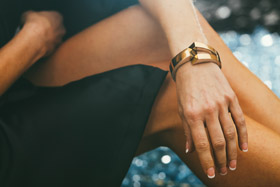Be Wise
 In an age where women are traveling alone more and more often, both for business and pleasure, there needs to be a way to monitor personal safety and send an alarm if necessary. WiseWear is a fashion tech hybrid company that creates innovative luxury wearables. Its Socialite Collection is a line of luxury smart bracelets that conceal advanced technology inside luxurious jewelry, helping women stay safe, healthy and connected with style.
In an age where women are traveling alone more and more often, both for business and pleasure, there needs to be a way to monitor personal safety and send an alarm if necessary. WiseWear is a fashion tech hybrid company that creates innovative luxury wearables. Its Socialite Collection is a line of luxury smart bracelets that conceal advanced technology inside luxurious jewelry, helping women stay safe, healthy and connected with style.
Available in three distinct designs—Kingston, Duchess and Calder—bracelets include mobile notifications, distress messaging and activity tracking. Each is made of high-quality brass and plated in precious metals such as gold and palladium, offering water resistance and longevity. They’re also interchangeable, giving users the ability to swap styles easily by detaching the top and bottom halves. It’s a true fusion of fashion, form and function into one sophisticated accessory.
Helping Bay Area Festivals Go Cashless
If you attended Outside Lands this year, you might have noticed a new development in operations, by way of RFID (radio frequency identification) wristbands. This year, festivalgoers wore wristbands that included an identification chip, scanned upon entrance to the festival. The chip not only served as a participant’s ticket, but also their wallet. PayPal worked as the exclusive payment processer behind the bracelets, so attendees could go cashless at all food, drink and merchandise vendors. This year, that included access to more than 80 restaurants and almost 80 bars and wineries.
PayPal’s Senior Director of Global Initiatives Anuj Nayar details the thought process behind the change: “We’d already tried it in festivals in Europe, and from both a consumer and merchant point of view, it makes sense,” he says. “With this, there’s convenience and security. It makes for an easy consumer experience, and merchants don’t have to deal with so much cash, so there’s less money mix-ups.”
Users registered their wristbands on the Outside Lands website or app, created a cashless account, then logged in and loaded pre-paid credits into their account. To pay, users tapped their wristband on an RFID reader located at each vendor and the order amount was deducted from the account.
For those who didn’t remember or know how to use the cashless option, ATMs were still available and vendors accepted cash. The future may be arriving, but it will give us time to catch up.
Strange But True
 Q. Though one antedates the other by almost 200 years, what’s an amazing similarity between a microscope and a smartphone?
Q. Though one antedates the other by almost 200 years, what’s an amazing similarity between a microscope and a smartphone?
A. As of 2014, there were some 7 billion cell phones in use worldwide, with each serving as a potential mobile medical clinic, “an opportunity to diagnose, track and ultimately prevent disease,” reports Kalee Thompson in Time magazine’s special edition on Great Scientists.
Aydogan Ozcan, a professor of electrical engineering at UCLA, has designed small, inexpensive smartphone add-ons that can convert “a cell phone into a sophisticated microscope able to detect diseases from malaria to tuberculosis to HIV.” Today’s 40-megapixel model is a processing powerhouse capable of seeing a virus the size of a single hair divided by a thousand.
Smartphone-enabled medical gadgets can carry out diagnostic tests using disposable plastic cassettes, with receptacles for a sample of body fluid, usually blood or saliva. The resulting patterns are captured by the phone’s optics and analyzed onsite, then the findings shared quickly with distant labs for further analysis of the disease. Ozcan says, “You’re giving developing countries tools that are extremely compact and cost-effective, as if they were from a million-dollar-funded lab.”
Source: Bill Sones and Rich Sones, Ph.D.



